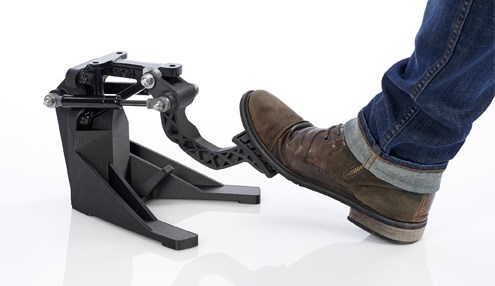Stratasys Direct Manufacturing announced it is now offering parts built with FDM Nylon 12 Carbon Fiber, in conjunction with Stratasys’ offering of the material for their F900 and 450mc systems. Nylon 12 Carbon Fiber is ideal for functional prototyping and production parts in high-requirement applications.
Production grade nylons utilized in 3D printing build tough, durable parts that are accurate, repeatable and stable over time. Additive manufacturing nylons create tough and geometrically complex components in a wide variety of applications. Nylon parts tend to be strong and heat resistant.
Stratasys Direct Manufacturing previously offered Nylon 12 in FDM. Nylon 12CF adds chopped carbon fiber reinforcement 35% by weight to enhance the mechanical properties of the Nylon 12 material. The resulting carbon fiber-filled thermoplastic exhibits ESD properties that delivers the highest strength and stiffness to weight ratios of any FDM plastic.
Nylon 12CF has significant advantages in strength, temperature resistance and other mechanical properties compared to other FDM materials. The most significant increase in strength and stiffness is in the XY horizontal axis of the build, as the fibers are aligned with the XY plane. This is beneficial in cases like a box geometry with tabs built vertically, as the tabs will have more flexibility to snap into the mating component.
FDM Nylon 12CF is an ideal solution for heavy components in need of stiff and light-weight materials. The material is an excellent option for applications with high functional requirements, often being used as a replacement for metal applications. FDM Nylon 12CF uses support material that is easily dissolved away, allowing for complex geometries that don’t require post-processing.
Due to FDM Nylon 12CF’s enhanced mechanical properties and inherent ESD properties, the material can withstand the rigors of the manufacturing floor. 3D printing allows for part consolidation, and Nylon 12CF is a great alternative for light-weight applications such as jigs and fixtures, end-of-arm tooling, under-hood applications, enclosures, brackets, and metal forming tools such as hydroforming. Like other FDM materials, Nylon 12CF can be post-processed with machining and inserts can be heat-staked or embedded during the build.
In-house at Stratasys Direct Manufacturing we’ve already found a use-case for the material. A metal lathe gear on one of our post-processing machines broke after 20 years of operation. Instead of trying to order a replacement from the machine’s manufacturer, engineers at Stratasys Direct decided to print their own. They printed the gear in Nylon 12CF in 3.5 hours. The result was a wear-resistant gear capable of operating the different loads the lathe experiences.





